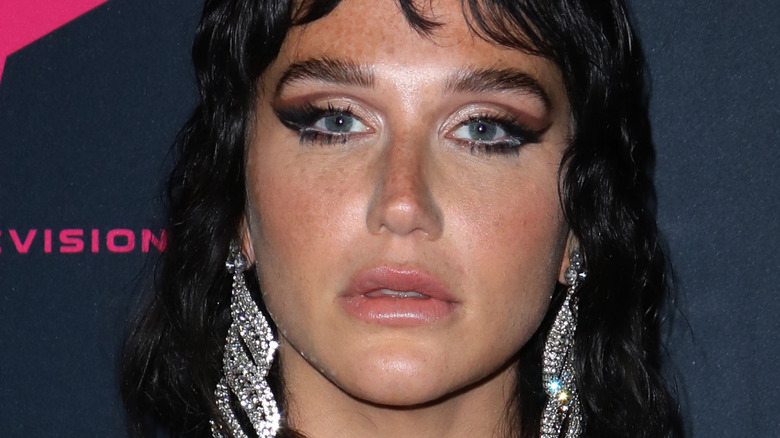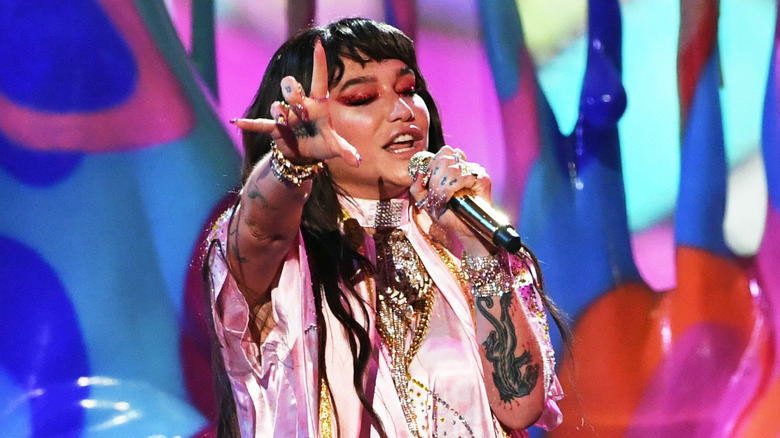Music Video Breakdown: ‘Praying’ by Kesha
The video matches the music in that the song starts off lonely and questioning. We first see Kesha alone in the video, drifting on wood, and later walking by screens questioning God and beauty standards. Subsequently, she gets off the plank on the water when a colorful bird inspires her to stand, and she smashes the TV screens. It signifies her fighting for herself.
The Real Meaning Behind Kesha’s Praying Lyrics

Kesha may have started her career by releasing a series of catchy pop tracks, including “TiK ToK,” “We R Who We R,” “Take It Off,” and “Your Love is My Drug” in 2010 (per Billboard), but when she staged a comeback in 2017 after years of legal drama with her former producer, Dr. Luke, it was a song about prayer that got people talking. Following the release of the single, which featured Kesha opening up about the devastating mental health struggles she had experienced, she shared an essay with Lenny Letter, via PopBuzz, and explained the meaning behind the emotional track.
“I have channeled my feelings of severe hopelessness and depression, I’ve overcome obstacles, and I have found strength in myself even when it felt out of reach. I’ve found what I had thought was an unobtainable place of peace. This song is about coming to feel empathy for someone else even if they hurt you or scare you,” Kesha wrote. As fans of the 34-year-old singer may know, Kesha accused Dr. Luke of sexual assault and battery in 2014 (per Pitchfork), claiming he gave her a date rape drug after convincing her it was a “sober pill” and raped her after she fell unconscious.
“It’s a song about learning to be proud of the person you are even during low moments when you feel alone. It’s also about hoping everyone, even someone who hurt you, can heal,” she added.
If you, or anyone you know, have been a victim of sexual assault, help is available. Visit the Rape, Abuse and Incest National Network (RAINN) website or contact RAINN’s National Helpline at 1-800-656-HOPE (4673).
Kesha had a breakthrough after her messy court battle

Kesha went on to say, in her Lenny Letter essay, that “Praying” was a song she wrote “about that moment when the sun starts peeking through the darkest storm clouds, creating the most beautiful rainbow.”
“Once you realize that you will in fact be OK, you want to spread love and healing. If you feel like someone has wronged you, get rid of that hate, because it will just create more negativity,” she said. According to Kesha, prayer is the one thing she found that gave her great relief through her darkest times. She also said that when it came to her feelings of anger and resentment, they only added more stress and anxiety to her life. “Hate is the fuel that grows the viruses. Don’t let anyone steal your happiness!” she said.
Two years after Kesha filed her suit against Dr. Luke, she dropped her case against him in 2016 (per Pitchfork), revealing plans to focus instead on getting back to her career and releasing new music.
If you or someone you know is struggling with mental health, please contact the Crisis Text Line by texting HOME to 741741, call the National Alliance on Mental Illness Helpline at 1-800-950-NAMI (6264), or visit the National Institute of Mental Health website.
Music Video Breakdown: ‘Praying’ by Kesha
Thus, begins Kesha’s “Praying” video. She is lying in a casket with a huge cross behind her while two figures wearing the heads of pigs stand on either side. It cuts to a black-and-white image of her lying on wood floating on water. She questions a possible higher power about her suffering. The references to her suffering might be a reference to a civil court’s dismissal of her sexual assault, harassment, and gender violence allegations against music producer Dr. Luke.
The video, like the song, differs greatly from Kesha’s other videos. It purposefully showcases Kesha’s vulnerabilities by, quite literally, having her on her knees as if she were praying and having tears roll down her face. She no longer shows an uncaring attitude, as in “Tik Tok.” Emotion is in the spotlight of the video.
The costumes and props are all colorful and light, which works to contrast some of the scenes’ inherently melancholic components and helps with the transition to inspirational aspects of the video. Kesha paints her face with neon colors. Her costumes feature feathers, glitter, and butterflies. Many of the props are religious symbols such as crosses, candles, and angel wings. Mid-video, a variety of television screens show questions relating faith, truth, and God. Other similar messages appear in other parts of the video, such as “God is love.” “Standards of beauty”—Kesha has spoken about struggling with eating disorders in the past—is a phrase that pops out.
The video matches the music in that the song starts off lonely and questioning. We first see Kesha alone in the video, drifting on wood, and later walking by screens questioning God and beauty standards. Subsequently, she gets off the plank on the water when a colorful bird inspires her to stand, and she smashes the TV screens. It signifies her fighting for herself.
This video successfully works alongside the song to recognize hardship, yet simultaneously inspires advocacy for oneself. Kesha was not going to let herself die—unlike Taylor Swift.
—Staff writer Kamila Czachorowski can be reached at [email protected].
]]>
